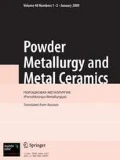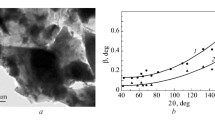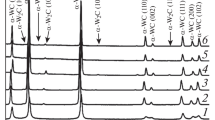Conclusions
A study was made of the solid- and liquid-phase sintering kinetics of tungsten-alumina cermets. The energy of activation for the sintering of the cermets was determined. The free surface energy of tungsten, the boundary free energy of tungsten, and the surface energy at the tungsten-alumina, boundary were evaluated. The structure of the cermets was studied.
On the basis of experimental results, conclusions are drawn regarding the mechanism of mass transport in the sintering of tungsten-alumina cermets. In the first stage of sintering, the processes taking place are linked with the migration and annihilation of line defects. In the second stage of sintering, shrinkage is limited by processes of volume self-diffusion in tungsten. The presence of a liquid phase activates processes occurring both in the first stage of sintering, by creating an additional driving force for the process of activated sliding on boundaries, namely, the surface tension of the melt, and in the second stage of sintering, by establishing conditions enabling mass transport to occur in the tungsten by a boundary diffusion mechanism.
Similar content being viewed by others
Literature cited
T. F. Frangos, Mater. Design Eng., No. 2, 112 (1958).
F. Heitzinger, Austrian Pat. No. 297533, publ. Mar. 27, 1972.
A. I. Avgustinik, V. S. Vigdergauz, et al., in: Investigations in the Field of Silicate and Oxide Chemistry [in Russian], Nauka, Moscow-Leningrad (1965), p. 257.
I. V. Fedina, P. P. Kalitin, and F. Ya. Kharitonov, Poroshkovaya Met., No. 6 (1968).
B. S. Mitin and V. Ya. Levin, Izv. Akad. Nauk SSSR, Neorgan. Mat., No. 10, 1964 (1968).
V. P. Elyutin, V. I. Kostikov, et al., Izv. Akad. Nauk SSSR, Neorgan. Mat., No. 12, 2208 (1965).
J. J. Rasmussen, J. Am. Ceram. Soc., No. 6, 300 (1972).
P. S. Kislyi and M. A. Kuzenkova, Poroshkovaya Met., No. 10 (1969).
E. N. Hodkin, M. I. Nicholas, and D. M. Poole, J. Less-Common Metals, No. 2, 93 (1970).
B. C. Allen, J. Less-Common Metals, No. 3, 263 (1972).
R. B. Kotel'nikov, S. N. Bashlykov, et al., A Handbook of Extra Refractory Elements and Compounds [in Russian], Metallurgiya, Moscow (1969).
N. C. Kothari, J. Less-Common Metals, No. 2, 140 (1963).
Author information
Authors and Affiliations
Additional information
Translated from Poroshkovaya Metallurgiya, No. 9 (141), pp. 27–32, September, 1974.
Rights and permissions
About this article
Cite this article
Storozh, B.D., Kislyi, P.S. Sintering of tungsten-alumina cermets in the presence of a liquid phase. Powder Metall Met Ceram 13, 712–716 (1974). https://doi.org/10.1007/BF00797715
Received:
Issue Date:
DOI: https://doi.org/10.1007/BF00797715




